
|

|
Forum Index : Electronics : Inverter for a Tiny Home - help wanted...
| Page 1 of 2 |
|||||
| Author | Message | ||||
Grogster Admin Group Joined: 31/12/2012 Location: New ZealandPosts: 9817 |
Hello all.  I am in New Zealand as many of you will know, and I have some parts for an inverter, and I now find myself in the situation where I might need to leave the house I live in now, and setup in a tiny-house. This is actually quite an exciting concept for me, and so I find myself thinking about the power requirements of such a relocation. I would mount solar panels on the roof of the tiny home. Heating/Cooking/Water-heating will be provided for using a wood-fire/oven with wetback, so that is no issue, and will not be a load on the electrical that I need to consider. I only need stable 230v PURE-SINE-WAVE juice to run some LED lights, and my computers and servers. Washing and drying of clothes I will do at the local community laundromat, so there is no need to be able to power a washer and dryer, although, I am considering natural washing and drying on an air-line. Shower will be to gray-water tank, or perhaps even just use the local pool showers. Black-water is not a concern, as I plan to use a composting toilet arrangement, so there will be no septic tank situation. I will post again here tomorrow, with the bits that I DO have here for an inverter, but I would much prefer to do the inverters as documented here over the years, over paying pretty rich prices for "Commercial" inverter arrangements. LOTS to think about.....  Smoke makes things work. When the smoke gets out, it stops! |
||||
Revlac Guru Joined: 31/12/2016 Location: AustraliaPosts: 1214 |
If you can, try to keep the shower and laundry stuff in your plan, going to a Laundromat or public place to do this stuff can be stress (PITA) you don't need. Your inverter should be built powerful enough so that there is plenty of head room for running more loads than you initially plan, typical of many solar off grid users, we find more things later we can plug in and use.  Cheers Aaron Off The Grid |
||||
Grogster Admin Group Joined: 31/12/2012 Location: New ZealandPosts: 9817 |
You have a point. A good one. I will look at redesigning to allow for a washer and dryer. Not sure if a home-baked inverter can handle that kind of load though. I KNOW that the inverter designs posted here, have gone through some revisions and are really rather good now, but I have been out of the loop for a few years, so those in the know who have built these - please do post. I did not get a chance to take photos of what I have here, but I can say that I have lots of major bits, including the all-important toroidal transformers, but they have not been modified or had the heavy-duty primary done etc, so I might need to have my hand held a bit for this....  I will do my best to post pictures of what I have tomorrow, and then perhaps we can make a start on building something, long before it is actually needed.  Smoke makes things work. When the smoke gets out, it stops! |
||||
| Murphy's friend Guru Joined: 04/10/2019 Location: AustraliaPosts: 673 |
My house runs off grid. The inverter easily handles the washing machine.I would not even consider running a dryer. My washing is done on sunny (dry) days with plenty of solar to keep the batteries charged while the washing machine is on. Drying is directly solar, on a washing line  |
||||
| KeepIS Guru Joined: 13/10/2014 Location: AustraliaPosts: 1997 |
Washers and dryers are now considered baby loads, even combined with a few fridges, computers and an Air con running  IMHO it will come down to the physical size constraints you have, the weight (toriod) and the available battery space, the main Inverter limitation will likely be keeping the Toriod cool when compromising size and weight. A smaller toriod limits your run time with continuous loads above a kW or so, if the secondary winding is up to it then forced cooling of the Toriod would allow you some decent run time for a tiny-house. For a small installation, the limitation will likely be the amount of solar you have available, all the batteries in the world are useless if you can't charge them. IMHO Solar rules and the rest follow. In a tiny-house there will obviously be compromises, I'm assuming that you may need to plan for no available AC power ? If not, the battery verses available solar equation could vary. NANO Inverter: Full download - Only Hex Ver 8.2Ks |
||||
| phil99 Guru Joined: 11/02/2018 Location: AustraliaPosts: 2916 |
Even on grid a conventional drier is a a poor choice. 2kW for many hours. Heat pump driers are more efficient but are very expensive. And unless it is an inverter type the compressor motor start current (up to 10 x running current) requires a very big inverter. In winter a clothes horse in front of the wood stove is the way to go. |
||||
| KeepIS Guru Joined: 13/10/2014 Location: AustraliaPosts: 1997 |
All very true, although some of us do use a low cost dryer for short periods under some weather conditions, to finish drying slightly damp clothes. It's also used to soften wet towels after spinning, only takes a few minutes before hanging them on the line to dry, similar load to boiling a jug. Like Grogster said, it's an exciting concept and it will be interesting to see what he comes up with. On the subject of washing machines. I've always been under the impression that a washing machine running for a hour or so consumed a lot of power, but I'm amazed at how little power the front loader we use actually consumes on a cold wash. Right now the total inverter output is showing 480 Watts. The house and workshop are running off grid, workshop lights, computers, 2 X Fridge freezers, all kind of plug packs and standby loads, obviously no workshop gear, stove or jugs running. The base load cycles up to 680 watts as various white goods cycle on and off for short periods, but it's amazing how little we use. Once the washing is finished we drop down to around an average of 340 Watts base load. NANO Inverter: Full download - Only Hex Ver 8.2Ks |
||||
Revlac Guru Joined: 31/12/2016 Location: AustraliaPosts: 1214 |
Most modern washers use bugger all power on cold wash, I have an old LG Front loader, just remember to turn it off at the wall as it is chewing 12w continuous doing nothing, I suspect other brands might be similar, worth checking.  Cheers Aaron Off The Grid |
||||
Grogster Admin Group Joined: 31/12/2012 Location: New ZealandPosts: 9817 |
Very informative posts - thanks. I would probably prefer to go with a PCB and setup that others here have already proven to work, rather then my trying to redesign the inverter wheel, if you catch my drift.  I do a lot of PCB design work, but why bother when others have already done it and worked out any of the design issues, and now have a stable setup? (rhetorical!) I will take some photos today of what I have, and post them here so you all can see. From what I remember of the toroid's, they still have the manufacturer labels on them, so I will make sure to get a good photo of that. Smoke makes things work. When the smoke gets out, it stops! |
||||
| phil99 Guru Joined: 11/02/2018 Location: AustraliaPosts: 2916 |
The idea that washing machines use a lot of power dates back to the 1950s to'70s when many top loaders had heating elements. Many houses had inadequate hot water supply, the detergents didn't work well in cold water and most fabrics were cotton which cleans best at high temp. The ones without heaters didn't use much more energy than modern ones. |
||||
| Godoh Guru Joined: 26/09/2020 Location: AustraliaPosts: 600 |
Hi Grogster, I go along with those who say forget a clothes dryer. We live totally off grid, have done now for 40 odd years. Never had a clothes dryer and never needed one. As others have said just wash on days when the sun is going to be out. As far as inverters go, I have three running A Latronics inverter 2300 watt that runs the house, and two 8010 based inverters that run the shed and a small cabin. If you are after easy, reasonably cheap and reliable inverters and you have a transformer already ( as you say). Then the aliexpress 8010 based boards are easy fast and have proven very reliable to me. I have seen quite a few second hand inverters on Gumtree. But if you have the parts then it is still cheaper to make your own. Having space on a tiny home for enough panels may be an issue, but if you are in a fixed place then a ground mounted rack would be the way to have more panel space. I have two ground mounts, as my roof is not big enough for more than about 2kw of panels. So the ground mounts have 3kw of panels on them. I made mine with treated pine posts and 150 x 25 mm treated pine rails to mount the panel racks to. It gets very windy where we are at times so the ground mounts are built very strongly. In a sheltered place you could make lightweight demountable racks. Good luck Pete |
||||
Revlac Guru Joined: 31/12/2016 Location: AustraliaPosts: 1214 |
PCB's and things, https://www.thebackshed.com/forum/ViewTopic.php?TID=13650&P=7 there are some other threads as well. Cheers Aaron Off The Grid |
||||
Grogster Admin Group Joined: 31/12/2012 Location: New ZealandPosts: 9817 |
Hello everyone.  Here are the photos of what I have - I had more then I thought, actually. 2x Toroids: 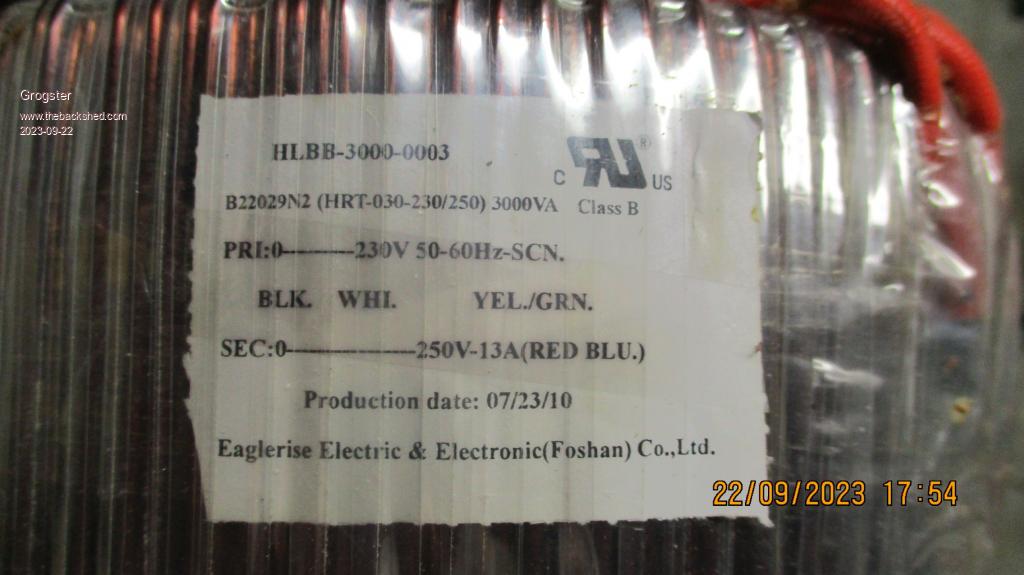 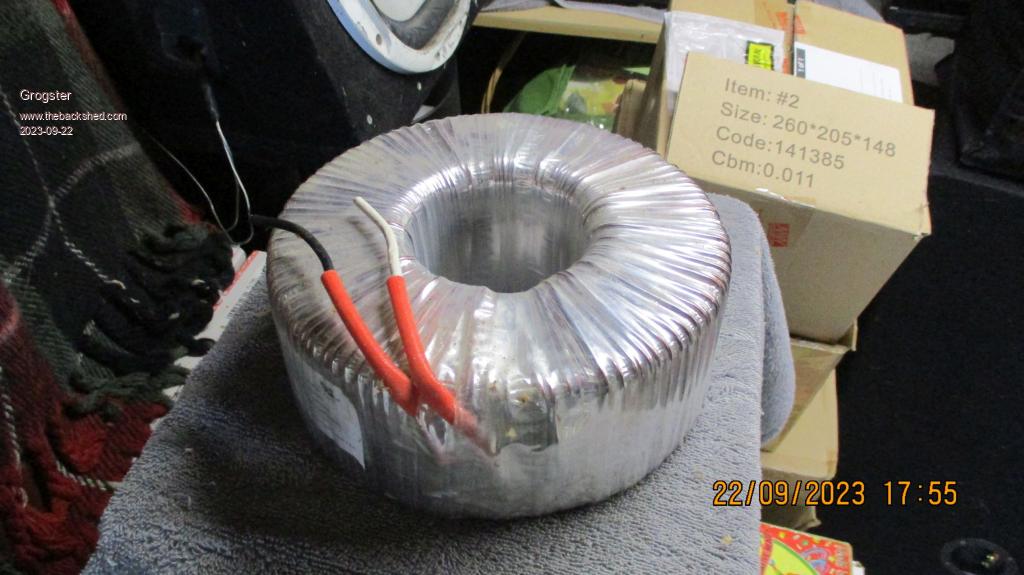 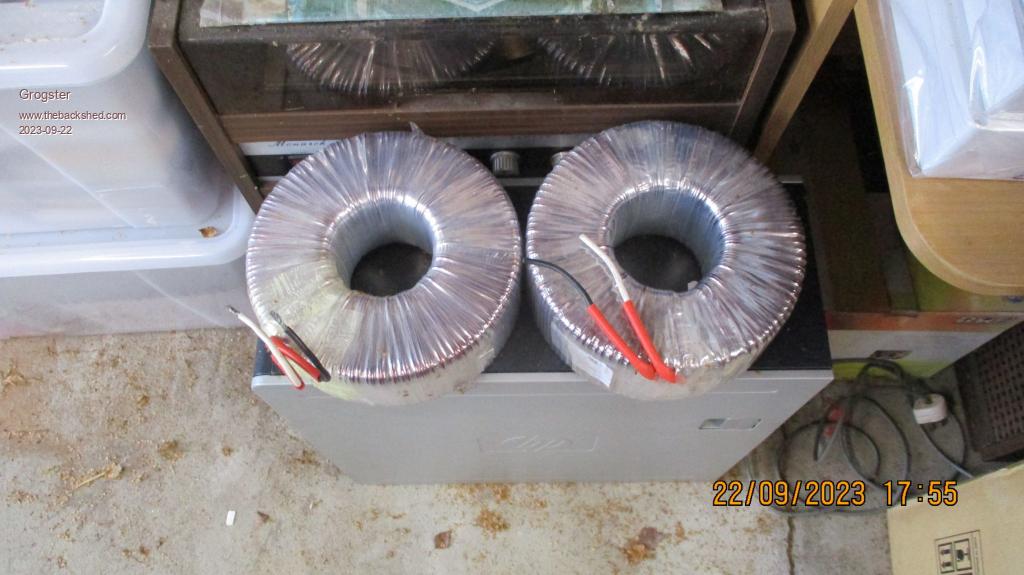 These only have ONE winding on them, so they seem to have had one winding removed already, and look to be ready to accept the chunky LV winding directly - I think. 3kW units, so good for up to 16A surge I would imagine - please comment. Pre-assembled inverter board: 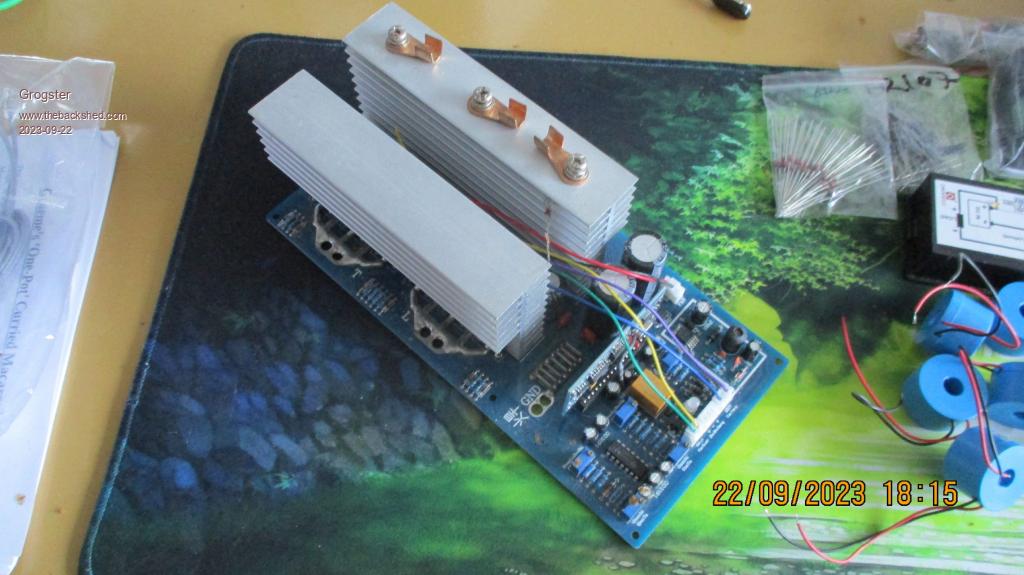 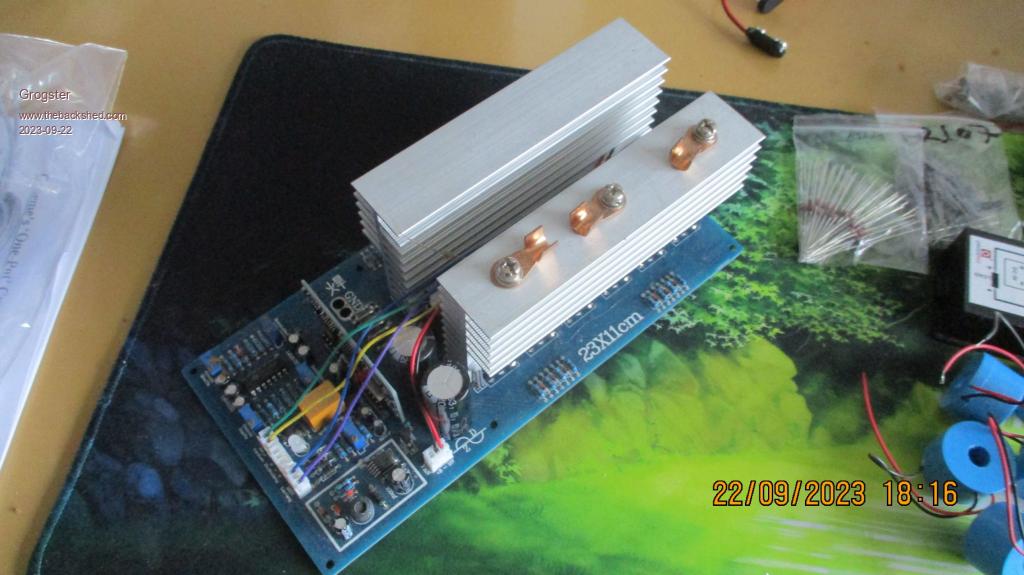 As I understand things, as of NOW, this board is no longer a good choice, mainly due to lack of robust MOSFET gate drivers, and so the MOSFET's can pop without too much abuse on these boards. I am currently researching the "Picoinverter" controller paired with a Madness power board as suggested in the other thread I was linked to. Other bits: 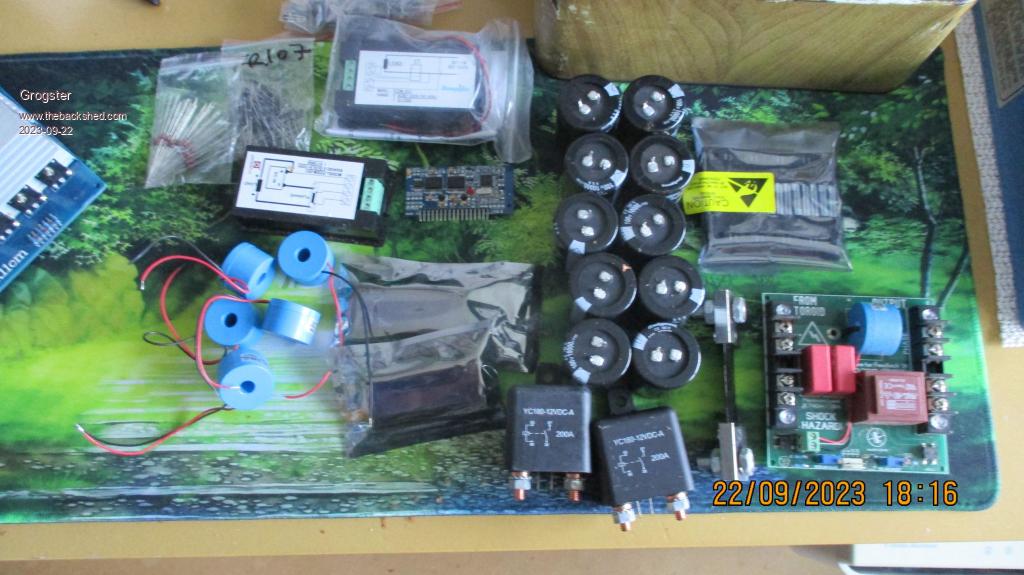 Diodes, couple of LED panel meters, LCD panel meters, CT's, 200A relays, 10,000uF 100v electrolytic's, fusible-link, my attempt at a current and voltage feedback module, and a bag of twenty HY4008 MOSFET's. The mission-critical thing is the toroid's, and so with those, I am hopeful I can try to build something that works for the modest power requirements I plan to have. Any and all comments welcomed. Smoke makes things work. When the smoke gets out, it stops! |
||||
| pd-- Senior Member Joined: 11/12/2020 Location: AustraliaPosts: 122 |
One Toroid will easily do that , with forced cooling you could get 5kva out of one peek current would be more like 50A for 30>60 sec , its just dependent on the FETS in the inverter and battery assuming you do a 48v version. There is nothing wrong in running a transformer worm especially in a cold damp environment. |
||||
Grogster Admin Group Joined: 31/12/2012 Location: New ZealandPosts: 9817 |
What are you suggesting?       Seriously though, that is excellent news.  And yes - it is much colder over here in Kiwi-land then it is in Aussie, so there is that. WHAT I WANT TO RUN: For everyone to get an idea of what I WANT to run, here is a very basic run-down: - LED lights in all rooms - Three, maybe four computers(24/7/365) * - Washing machine - Video projector - Raspberry Pi Media-player - A few network switches - Home Theatre amplifier - Some kitchen appliances such as jug, sandwich press, perhaps a Microwave * I would LIKE the server PC(one of) to run 24/7/365, but I am willing to power-down this machine if I have to. It will have it's own UPS backup. I PLAN AT THIS STAGE to use a wood-burning stove+oven+wetback. I have not decided on the wetback thing yet, but I do plan to have a wood-fired stove and oven, which will also heat the tiny-home easily - and will require no electric heating, only a stockpile of nice dry wood.  Smoke makes things work. When the smoke gets out, it stops! |
||||
Revlac Guru Joined: 31/12/2016 Location: AustraliaPosts: 1214 |
I don't see any choke core amongst the parts in the photo's. Cheers Aaron Off The Grid |
||||
| phil99 Guru Joined: 11/02/2018 Location: AustraliaPosts: 2916 |
Long ago had a Rayburn stove / oven with a wetback. In that the wetback was the back of the firebox. When it rusted out found a replacement way too expensive so replaced it with a slab of firebrick. Wood consumption dropped dramatically. In summer the hot water power bill also dropped. It turns out this type cools the fire before combustion is complete so much of the wood was going up the flue as unburnt gasses and soot. When the fire isn't burning the thermosyphon continues, taking heat from the HW tank, wasting power. The type to get is a pipe grid that sits between the top of the firebox and the hotplate. Instead of thermosyphon use a small circulating pump and check-valve to prevent reverse flow when the pump isn't running. Another option is a flue heat exchanger. Can be added to any wood heater. Use circ. pump as above. The electronics connection is the thermostat to stop - start the pump. That should justify my ramblings in this forum. |
||||
Grogster Admin Group Joined: 31/12/2012 Location: New ZealandPosts: 9817 |
You don't. Cos I don't have one. I would welcome suggestions. Smoke makes things work. When the smoke gets out, it stops! |
||||
Grogster Admin Group Joined: 31/12/2012 Location: New ZealandPosts: 9817 |
@ phil99 - Excellent advise, thanks.  I will look into this. Smoke makes things work. When the smoke gets out, it stops! |
||||
| pd-- Senior Member Joined: 11/12/2020 Location: AustraliaPosts: 122 |
A flue heat exchanger works a treat Hear is a pic of our Rayburn with a axeman fireflue the HWS is behind the wall and above the stove. On the subject of power how many panels & battery capacity are you budgeting for It sounds like your 24/7 power consumption is going to addup. you could be looking at a continuous 1kw load running the computers. |
||||
| Page 1 of 2 |
|||||
| The Back Shed's forum code is written, and hosted, in Australia. | © JAQ Software 2026 |